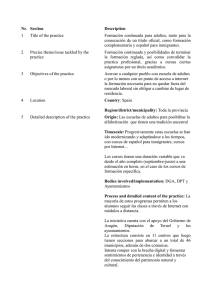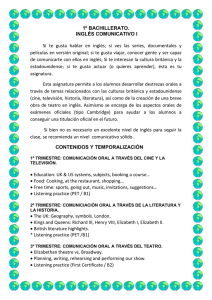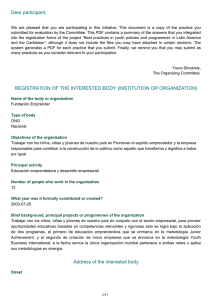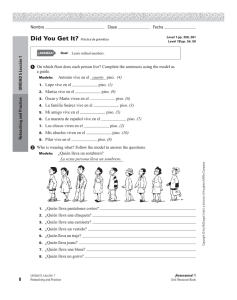Dear participant, REGISTRATION OF THE INTERESTED BODY
Anuncio
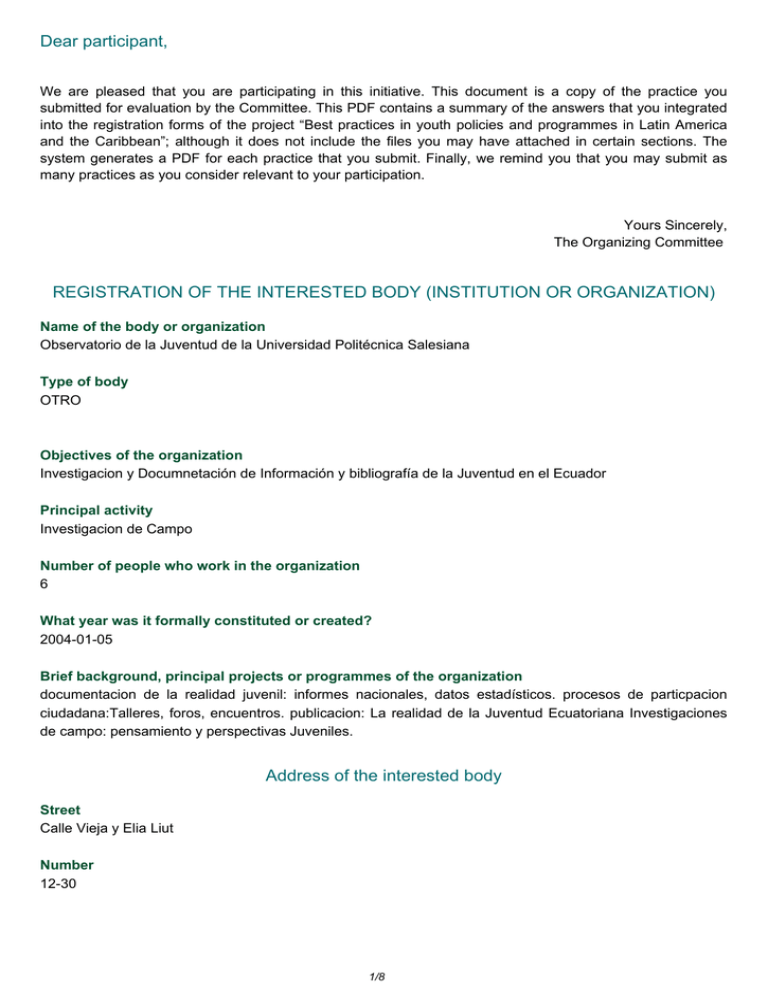
Dear participant, We are pleased that you are participating in this initiative. This document is a copy of the practice you submitted for evaluation by the Committee. This PDF contains a summary of the answers that you integrated into the registration forms of the project “Best practices in youth policies and programmes in Latin America and the Caribbean”; although it does not include the files you may have attached in certain sections. The system generates a PDF for each practice that you submit. Finally, we remind you that you may submit as many practices as you consider relevant to your participation. Yours Sincerely, The Organizing Committee REGISTRATION OF THE INTERESTED BODY (INSTITUTION OR ORGANIZATION) Name of the body or organization Observatorio de la Juventud de la Universidad Politécnica Salesiana . Type of body OTRO . Objectives of the organization Investigacion y Documnetación de Información y bibliografía de la Juventud en el Ecuador . Principal activity Investigacion de Campo . Number of people who work in the organization 6 . What year was it formally constituted or created? 2004-01-05 . Brief background, principal projects or programmes of the organization documentacion de la realidad juvenil: informes nacionales, datos estadísticos. procesos de particpacion ciudadana:Talleres, foros, encuentros. publicacion: La realidad de la Juventud Ecuatoriana Investigaciones de campo: pensamiento y perspectivas Juveniles. . Address of the interested body Street Calle Vieja y Elia Liut . Number 12-30 . 1/8 State, Department or District . City, Commune, Municipality or Province Cuenca . Postal code . Country Ecuador . Telephone 1 Celular 593-91639567 . Telephone 2 Oficina 593- 7 2862213 . Fax 593-72869112 . Email of subscriber’s contact [email protected] . Webpage www.ups.edu.ec . 2/8 IDENTIFICATION OF THE PRACTICE Name of the project or programme EXPECTATIVAS LABORALES JUVENILES . Principal thematic area Employment . Sub-area Training and employment services component. Creation and development of education programmes for job-seeking and, in general . Territory benefited by the activity Ciudad / Estado País / Países . Key dates of the policy Start : 2009-01-01 Ends Defined : 2009-11-14 . Is the programme or project part of a public policy? No . DESCRIPTION OF THE PRACTICE On what basis was this practice developed? Consulta de expertos, población, gobierno, etc . Situation prior to undertaking the practice and apraisal of the social context of the problem to solve or need to satisfy La no identificación de la juventud con las políticas publicas, la busqueda del reconocimiento y apoyo objetivo de las y los jóvenes dentro de la sociedad y sus espacios . Objective Reconocer y difundir la expresion de la Juventud sea reconocida como propia, que parte de su imaginario, en base a 4 lineas base que afectan o se desenvuelve el actuar joven, como lo es la Educación, la Familia, El Sistema Político, y los Medios de Comunicación. . Description of the target population (Number of young people dealt with, ages, gender, geographic area, urban/rural domain, socio-economic level, youth in sitations of exclusion/vulnerability, indigenous populations, etc): el grupo proyectado son 400 jóvenes entre hombres y mujeres, en edades comorendidas entre los 16 y 29 años, de la ciudad de Cuenca, de la zona urbana y rural, de todos los estratos sociales, sin discriminacion de etnia, credo religioso, o manifestacion cultural . Description of the process / undertaking of the practice 3/8 El presente proceso investigativo, se desarrollo en base de conversatorios entre sus pares, la seleccion de dichos grupos, se ha tomado como referencia, la galaxia musical, institucion educativa, grupos de voluntariado religioso y no religioso, grupos políticos. . Strategies or methodology applied las metodologías utilizadas son: Exploratorias (Encuestas, Grupos focales, conversatorio, trabajos en grupo y posterior debate) Ronda de expertos Entrevista con especialistas . Age range of the beneficiary population: Start : 17 End : 24 . Number of direct beneficiaries : 400 Number of hours of participation of/capacity building for the targeted beneficiaries : 10 Number of people that execute or executed the practice: Estimate of women :180 and men : 220 TOTAL : 400 Of the total: How many of the people executing the practice are volunteers : 3 Of the total: Approximately what percentage are youths? : 70 . RESULTS AND IMPACT RESULTS Situation after undertaking the action or intervention Punto de referencia para el desarrollo de políticas públicas, y elaboracion de una posible reformulacion de la mallas académicas . Were the initial objectives achieved, or are they being achieved? Yes las convergencias encontradas en los aportes en los conversatorios con la juventud las manifestacion de jovenes en búsqueda de espacios . Have the results been evaluated, or are they being evaluated? Yes elaboracion de informes por taller generacion de un informe comun, por taller realizado . Are the results being systematized or documented? Yes se esta sistematizando los informes de los talleres para realizar informes periódicos trmestrales, y su producto final será una publicacion . Specific results achieved by the implementation of the practice: a) Improve the ties, coordination and integration of the different actors, organizations, and social and government institutions 4/8 Yes el desarrollo de redes entre organizaciones que trabajan con jóvenes el encuentro final de todos los/as jovenes que participaron en el proyecto . b) Promotes or drives the creation and/or reform of public policies and local, national or regional strategies. Yes el debate final entre las expectativas juveniles, entorno a lo planteado en la ley de la juventud y el desarrollo de políticas públicas. . c) Promotes new forms of inclusion in decision-making in local and national processes. Yes la participacion de la juventud en temas que afectan a su bienestar y que sus manifestaciones sean escuchadas y valoradas, sin prejuicio de discriminacion alguna . d) Fosters positive attitudes towards the development and integral inclusion of young people in the solution of social problems, as well as generating greater expectations among them. Yes la generacion de un debate, permite conocer su pensamiento, sus acciones y cuales son las expectativas que tienen a futuro los jóvenes . IMPACT . The impacts have been systematized or documented No . The impacts have been evaluated No . What are the impacts of the practice? El desarrollo de un encuentro de análisis de la propuesta educativa y la repercución laboral en la juventud . There are strategies to follow-up on the practice : Yes Evaluacion de informes . TOTAL COST AND FINANCING OF THE PRACTICE Total cost of the project: : 18 . Direct cost of the practice : 12 . Sources of funding: Universidad Politecnica Salesiana del Ecuador . Economic associations or alliances .No 5/8 SUSTAINABILITY AND OTHER CRITERIA Do any non-economic associations or alliances exist? No . Were young people included as decision-makers in the implementation of the practice? Considerably Los jovenes son quien participanda de los grupos focales, de las encuestas, y participaran en la ronda de expertos. . What role do young people play in the practice? Beneficiados,Participantes . Briefly explain the role of youth participation in the different stages of the practice en la aplicacion de encuestas, en los talleres grupales, en la ronda de expertos . The practice is linked to the protection of the environment Considerably . Does it integrate the gender perspective into the programmes/services offered to young people? Yes How does it integrate it into the service/programme methodolgies it currently offers young people? alternabilidad, y equidad en la participacion, mapeo . Where ICTs used in its execution? Somewhat email, internet, . Does it have a legal/rights perspective? No . Is your practice innvovate (methodologies, models, strategies, resources, etc.) No . Briefly explain why you think your practice should be selected as one of the best in the field? porque aun no se ha visibilizado el diálogo entre juventud educacion y trabajo, en el cual se inluya el pensamiento de los protagonistas que son los mismos jóvenes . REPLICABILITY AND LEASONS LEARNT REPLICABILITY Do you consider that the practice or model of your methodology is applicable? 6/8 Yes What are the necessary conditions and fundamental factors? basarnos del objetivo y tipo de grupo para la aplicacion de la metodología How? grupos focales, preguntas definidas, encuesta mayor cantidad de participantes . Have other bodies replicated your practice? No Explain: . LEASONS LEARNT . Main strenghts of the practice la diversidad de criterio, la riqueza del discurso de los jovenes, el interes despertado en particpar . Key criteria or opportunities for the success of the practice el interes de los involucrados (jovenes) y la accesibilidad de los expertos . Weaknesses of the practice la limitacion de la muestra . Threats of to the practice (external) and unexpected effects/consequences brought about by its implementation la no participacion de los expertos . OTHERS . If you wish to add information that you consider important and which enriches your practice (and which has not been considered in this registration form), we offer this space for you to do so . THEME-SPECIFIC QUESTIONS Theme - Employment Regarding the target/beneficiary population: . In the selection of the young people participating in the practice or those targeted by it. a) Were criteria of vulnerability taken into account? Yes , Which ones? edad, procedencia, . b) Is priority given to young people in a situation of greater social or economic vulnerability or is no distinction made? No . Regarding the description of the practices: 7/8 a) Did workers and employees, or others members of civil society (for example youth organizations) participate in the design of the practice? No . Regarding the impact: a) Specify how the practice has an impact on the integration of young people into the work force, on the quality of the work they gain access to (in terms of salaries, type of contract, social security coverage, conditions, etc.) or on the development of their entrepreneurial capacity. Please use quantitative information as much as possible to support your answer. aun no se puede ver esun plan a futuro minimo a un año, . b) Does the practice promote the creative capacity and the capacity to innovate of young people? Yes , How? Escuchando y en un futuro reslatar las expectativas de los jovenes sobre futuros emprendimientos . Would you care to add something to demonstrate that the practice is a good practice? . 8/8
